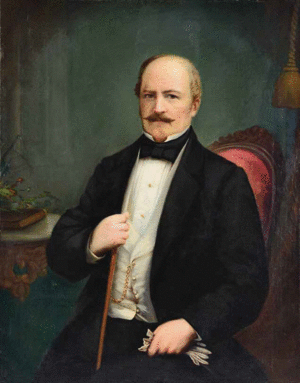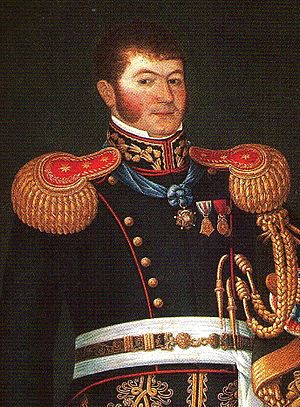Ramón Freire facts for kids
Quick facts for kids
Ramón Freire
|
|
|---|---|
 |
|
| 1st President of Chile | |
| In office 25 January 1827 – 8 May 1827 |
|
| Vice President | Francisco Antonio Pinto |
| Preceded by | Agustín Eyzaguirre |
| Succeeded by | Francisco Antonio Pinto |
| 3rd Supreme Director of Chile | |
| In office 4 April 1823 – 9 July 1826 |
|
| Preceded by | Bernardo O'Higgins |
| Succeeded by | Manuel Blanco Encalada (as President) |
| Personal details | |
| Born | 29 November 1787 Santiago, Chile |
| Died | 9 December 1851 (aged 64) Santiago, Chile |
| Political party | Pipiolos (1823-1849) Liberal Party (1849-1851) |
| Spouse | Manuela Caldera Mascayano |
| Signature |  |
Ramón Freire Serrano (born November 29, 1787 – died December 9, 1851) was an important Chilean political leader. He was the head of Chile several times. Many people supported him for a long time. Ramón Freire was a main leader of the liberal Pipiolo group. Some historians say he was the most democratic leader in Chile's early years as a republic.
Contents
Early Life and Beginnings
Ramón Freire was born in Santiago on November 29, 1787. His parents were Francisco Antonio Freire y Paz and Gertrudis Serrano y Arrechea. He became an orphan when he was young. His uncles raised him on a farm near Colina. At age 16, he became an orphan again. He then moved to Concepción where he worked in a store. Later, he worked on a merchant ship.
Fighting for Independence
When Chile started fighting for independence in 1810, Ramón Freire joined in. He was part of the first Junta. In 1811, he became a cadet in the Dragones de la Frontera. He fought in several battles during the Chilean War of Independence. These included Huilquilemu, Talcahuano, El Roble, and El Quilo.
By the time of the Rancagua disaster, he was a captain. This event marked the end of the "Old Homeland" period. He went into exile in Buenos Aires with many others. In 1816, he joined the Army of the Andes. He returned to Chile as a battalion commander. He helped take the city of Talca on February 11, 1817.
He also fought in the battle of Maipú. He was promoted to colonel for his help in gaining independence. He became the leader of Concepción under Bernardo O'Higgins. Over time, his friendship with O'Higgins weakened. In 1822, he resigned because he disagreed with O'Higgins. Many people who were unhappy with O'Higgins looked to Freire as their leader. However, they never fought each other.
Serving as Supreme Director
After O'Higgins resigned, Ramón Freire became the new Supreme Director. He held this important role from April 4, 1823, to July 9, 1826. After a short break, he returned to the position on January 25, 1827. He tried to resign on February 5, 1827, but Congress did not accept it. He was then elected president on February 15 of that year. He resigned again on May 5, 1827.
During his time as leader, he started many important changes. He helped end slavery in Chile. He also improved the defense of Valparaíso port. He opened Chile's markets to trade with other countries. Freire also supported freedom of the press. He ordered convents and monasteries to open free schools for everyone.
On December 29, 1823, he introduced a new constitution. This document tried to control both public and private life. It was very strict and did not work well. The constitution was stopped after only six months.
Chile's government had little money after the independence wars. It also owed money to British banks. Freire created a government monopoly on tobacco and alcohol. This was given to a company called Portales, Cea and Co. It did not work out well. This event was the first time Diego Portales was involved in government.
Freire also finished making Chile fully independent. He captured Chiloé Island, which Spain still controlled. After some battles in 1824 and 1826, he signed the Treaty of Tantauco. In this treaty, Spain finally gave up its claims to Chiloé.
Conflicts and Resignation
During his time as leader, Freire faced many problems. There were conflicts, especially with people who supported O'Higgins. These problems became so bad that Freire was removed from power in 1825. He was put back in charge when he returned. However, the many conflicts forced Freire to resign on July 9, 1826. He gave power to Admiral Manuel Blanco Encalada. Blanco Encalada became the first "President of the Republic."
Later Time as President
A new revolution brought Freire back to power on January 25, 1827. He was a temporary president. After things calmed down, he resigned again on February 5. But Congress refused his resignation. They confirmed him as president on February 15. He finally resigned for good on May 5, 1827.
During this time, there was an attempt to create a federal system of government. José Miguel Infante led this idea. The Chilean Congress passed laws to make this happen. The goal was to have a republic like the United States, with different states. But many conflicts started between the new "States-Provinces." This caused the new system to fail very quickly.
Later Life and Exile
Ramón Freire first retired to his farm. But soon he returned to politics. He was involved in the Chilean Civil War of 1829. His final defeat happened at the battle of Lircay. He was then put in prison and later sent away to Peru. In Peru, he got help from Marshal Andrés de Santa Cruz. Freire put together a small group and tried to capture Chiloé Island again.
He failed in his attempt. He was again put in prison at Valparaíso port. He faced a military trial. He was then sent away, first to the Juan Fernández island. After that, he went to Tahiti and for a short time to Australia in 1837.
He was allowed to return to Chile in 1842. He lived peacefully until he died on December 9, 1851.
See also
 In Spanish: Ramón Freire para niños
In Spanish: Ramón Freire para niños


